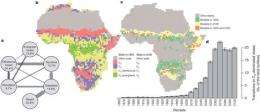Transitions between vegetation states projected for the period 1850-2100. Image (c) Nature (2012) doi:10.1038/nature11238
(Phys.org) -- In all the talk about global warming as a result of human created CO2 emissions, it seems other impacts of higher levels of carbon dioxide on the environment tend to get overlooked. One of those impacts, argue German researchers Steven Higgins and Simon Scheiter, who have been building models showing what impact such levels might have on vegetation, is a likely shift away from deserts and grasslands to more woody areas and forests. The two have written a paper describing their findings which has been published in the journal Nature.
Everyone that’s been to grade school knows that what we breathe out, plants breath in, and vice-versa, thus more of what we breath out, i.e. carbon dioxide (though from another source) should mean more for plants to breathe in, which should indicate better plant growth, more plant growth, or the switch from low level breathers to those that thrive on more CO2 in the air. Higgins and Scheiter suggest at least locally, that it’s the last possibility that might create the most change over the coming decades as the Earth’s vegetation slowly responds to finding more CO2 in the air.
The two restricted their area of study to the African continent and found first that because grasses that live in the savannah tend to need less CO2 to thrive than do trees, there are large swaths of the continent that favor savannah, which is demonstrated by the abundance of grasslands with the occasional stand of trees. Adding more CO2 to the mix is likely to change that balance they show, to favor tree growth over grasses, leading to more woodland. They also found that increased CO2 levels also tend to favor grasslands over deserts, which for Africa should mean decreasing desert sizes.
Throwing a wrench into the whole works though is water, of course, in the form of rainfall. If there is no rain, a desert will always be desert. But because of changes in topography, rainfall levels can vary dramatically over short distances leading to differences in the impact of rising CO2 levels. In areas with higher CO2 and adequate rainfall, the trend will be from savannah to forest, whereas in similar areas with less rainfall, tress might not be able to survive even with the addition of more CO2, thus the area would remain savannah.
This all means, the two write, that Africa is likely to see significant change over the next few decades as CO2 levels in the atmosphere continue to rise, causing significant changes to local areas of vegetation growth, depending on rainfall amounts, which will of course impact wildlife and the way the land is used by the people that live there, in ways that are impossible to predict.
More information: Atmospheric CO2 forces abrupt vegetation shifts locally, but not globally, Nature (2012) doi:10.1038/nature11238
Abstract
It is possible that anthropogenic climate change will drive the Earth system into a qualitatively different state1. Although different types of uncertainty limit our capacity to assess this risk2, Earth system scientists are particularly concerned about tipping elements, large-scale components of the Earth system that can be switched into qualitatively…
Journal information: Nature
© 2012 Phys.Org























